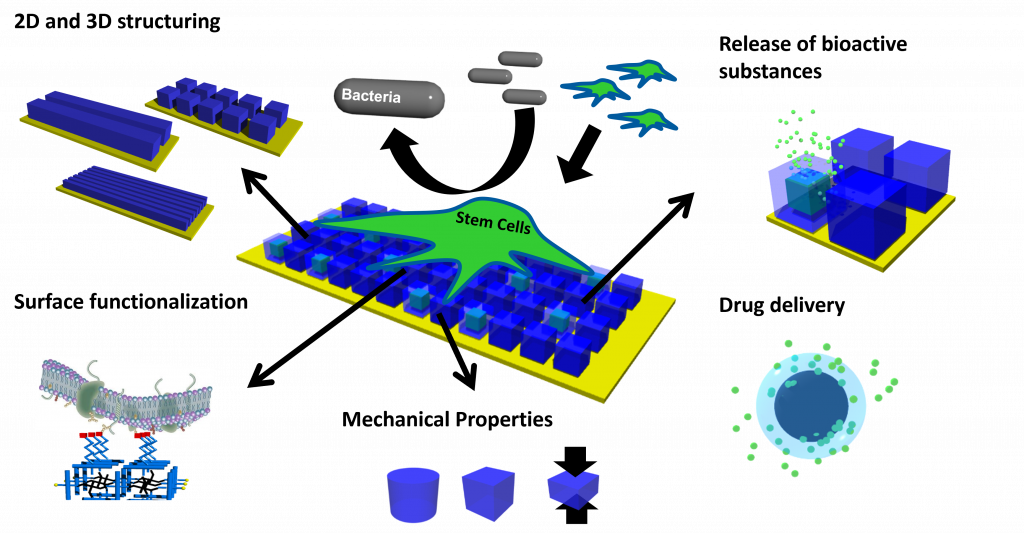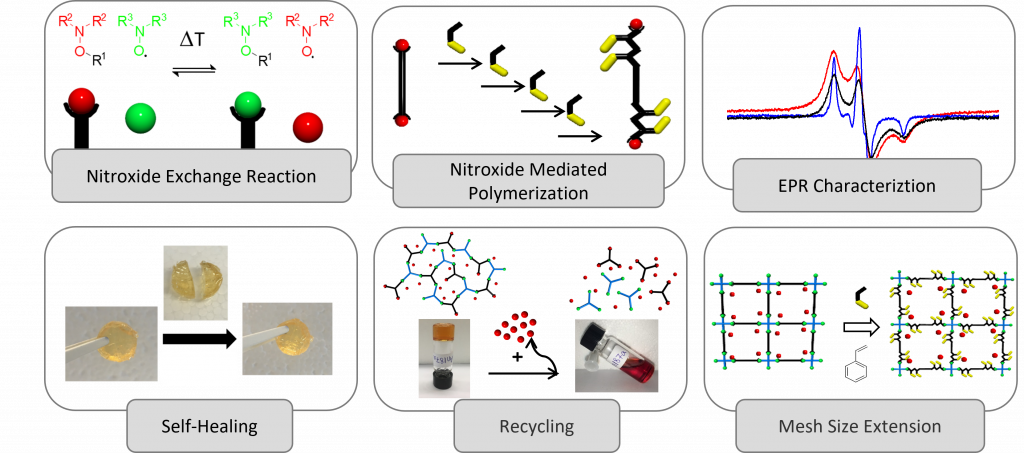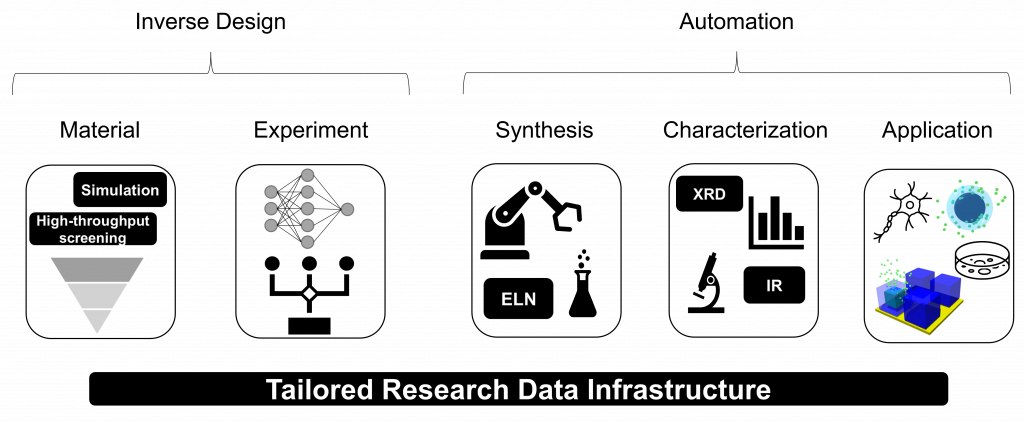We are material chemists working with porous materials and polymers.
Our goal is functionalization and hierarchical structuring (defined structures at multiple length scales) of the materials to optimize their interaction with biological systems.
MOF-templated Biomaterials
In our research group we develope new biomaterials for applications as bioinstructive cell culture substrates or multifunctional particles for medical imaging and diagnostics. We have been able to develop various techniques to control the structure of the biomaterials at the nanoscale and microscale. In recent studies, we were able to show that these materials can be produced as thin coatings on both surfaces and particles. In addition, we were able to load the materials with bioactive molecules or functionalize their surface. These functionalizations showed, for example, an improved interaction with growing cells or a controlled release of the incorporated active substances, which enables their application as cell culture substrates for multimodal diagnostics or drug transport.

MOF Polymer Hybrid Materials
In our group we design, functionalize and structure materials across different length scales. Most materials are based on the hybridization of metal-organic frameworks (MOFs) with polymers. MOFs are crystalline, highly ordered framework structures, which consist of metal centers and organic linkers. Hybridization of MOFs with polymers allows to combine the advantages of MOFs (precise molecular structure and high variability in composition and structure) with the advantages of polymers (stability in physiological conditions and biocompatibility).

Dynamic „Living“ Polymer Networks
In another project we have developed dynamic “living” polymer networks. The aim is to implement the reversible and dynamic nitroxide exchange reaction for the synthesis of covalently bound, organic polymer networks, which can dynamically change their properties, such as degree of crosslinking, mesh size or strength. In addition, the reaction progress can be monitored in situ by electron spin resonance (ESR) spectroscopy. By combining nitroxide exchange reaction (“NER”) with nitroxide mediated polymerization (“NMP”) in different sequences, the dynamic networks can be functionalized at any time, before, during and after synthesis, by incorporating monomers. This allows to control important properties, such as the mesh size or the degree of swelling. The combination of NER and NMP thus offers a versatile approach for the preparation of dynamic polymer networks with tailored properties.

Nanomembranes
The aim of the research project Nanomembranes is to produce porous polymers from modular, organic building blocks with precisely adjustable thickness by controlled layer-by-layer synthesis (see Fig. 4). The adjustable thickness, combined with the possibility of post-synthetic functionalization of the surface, enables the nanomembranes to be used in a wide variety of applications, such as gas or water separation or (electro)catalysis.

Computer-aided design and synthesis of MOFs
Projects on automation, modeling, data management, and machine learning.
The design and synthesis of hierarchically structured hybrid materials is very challenging. In addition, the interaction of the materials with biological systems is highly complex.
To enable faster and more efficient further progress in our biomaterial development, we integrate information-based techniques in biomaterial design, synthesis control and biological application. We are working on these goals in different projects with cooperation partners from theory and computer science. These activities are embedded in the Helmholtz program Materials Systems Engineering.

Inverse material design
The goal in inverse material design is to determine the ideal material composition and structure from a large chemical space, starting from the desired functionality. In this context, we have developed a geometric method to improve the post-synthetic modification of MOF materials. Thus, a high-throughput screening approach was developed to identify ideal MOF crosslinker pairs (see Figure 5). The algorithm considers spacing, angles, and arbitrary rotations to optimally match the crosslinker within MOF structures. In a second, independent step, we used molecular dynamics (MD) simulations to quantitatively confirm all matches identified by screening. The algorithm developed in this project can be extended to other network structures to aid in material design.
Automation
In addition, we are expanding the automation of synthesis and characterization (for example, through the funded project “Robotics-driven chemical synthesis”) with the goal of automatically storing the data in machine-readable form, increasing quality/reproducibility, and laying the foundation for autonomous experimentation.
Research data management
In order to store the self-generated research data in a machine-readable way and thus to be able to use it more sustainably, we are engaged in the German Research-Data Infrastructure, NFDI. Examples are the extension of Chemotion ELN and Repo as an electronic laboratory journal for MOF synthesis or the archive of MOF data in a machine readable (FAIR) format within NOMAD.